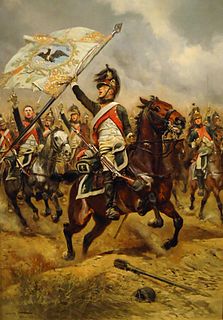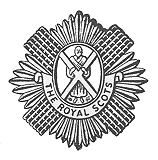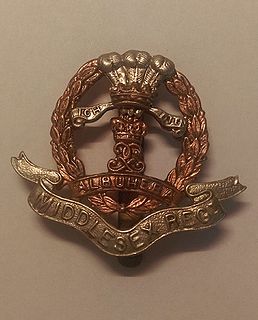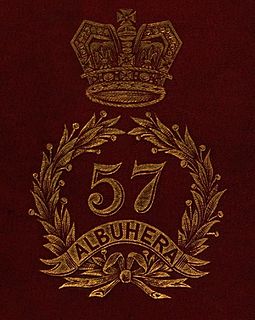
Dragoons originally were a class of mounted infantry, who used horses for mobility, but dismounted to fight on foot. From the early 18th century onward, dragoons were increasingly also employed as conventional cavalry, trained for combat with swords from horseback.

Operation Torch was an Anglo–American invasion of French North Africa during the Second World War. It was aimed at reducing pressure on Allied forces in Egypt, and enabling an invasion of Southern Europe. It also provided the ‘second front’ which the Soviet Union had been requesting since it was invaded by the Germans in 1941. The region was dominated by the Vichy French, officially Nazi-controlled, but with mixed loyalties, and reports indicated that they might support the Allied initiative. The American General Dwight D. Eisenhower, commanding the operation, planned a 3-pronged attack, aimed at Casablanca (Western), Oran (Center) and Algiers (Eastern), in advance of a rapid move on Tunis.
The Legion of Honour is the highest French order of merit for military and civil merits, established in 1802 by Napoleon Bonaparte and retained by all later French governments and régimes.

The Royal Scots , once known as the Royal Regiment of Foot, was the oldest and most senior infantry regiment of the line of the British Army, having been raised in 1633 during the reign of Charles I of Scotland. The regiment existed continuously until 2006, when it amalgamated with the King's Own Scottish Borderers to become the Royal Scots Borderers, which merged with the Royal Highland Fusiliers, the Black Watch, the Highlanders and the Argyll and Sutherland Highlanders to form the Royal Regiment of Scotland.

The Royal Netherlands Army is the land forces element of the military of the Netherlands.
The Punjab Regiment is an infantry regiment of the Pakistan Army. The modern regiment was formed in 1956 from an amalgamation of the 1st Punjab Regiment, 14th Punjab Regiment, 15th Punjab Regiment and 16th Punjab Regiment. Since then the regiment has expanded in strength to now include 47 battalions.

The 10th Royal Hussars was a cavalry regiment of the British Army raised in 1715. It saw service for three centuries including the First World War and Second World War but then amalgamated with the 11th Hussars to form the Royal Hussars in October 1969.

The King's Own Yorkshire Light Infantry (KOYLI) was a light infantry regiment of the British Army. It officially existed from 1881 to 1968, but its predecessors go back to 1755. In 1968, the regiment was amalgamated with the Somerset and Cornwall Light Infantry, the King's Shropshire Light Infantry and the Durham Light Infantry to form The Light Infantry, which in turn was merged with the Devonshire and Dorset Regiment, the Royal Gloucestershire, Berkshire and Wiltshire Regiment and the Royal Green Jackets to become The Rifles in 2007.

The Middlesex Regiment was a line infantry regiment of the British Army in existence from 1881 until 1966. The regiment was formed, as the Duke of Cambridge's Own , in 1881 as part of the Childers Reforms when the 57th and 77th Regiments of Foot were amalgamated with the county's militia and rifle volunteer units.

The 57th Regiment of Foot was a regiment of line infantry in the British Army, raised in 1755. Under the Childers Reforms it amalgamated with the 77th Regiment of Foot to form the Middlesex Regiment in 1881.

The 57th Battalion was an infantry battalion of the Australian Army. Formed in early 1916 for service during World War I, the battalion served on the Western Front until the end of the war, when it was disbanded. In 1921, it was re-raised as a part-time unit in Victoria, known as "The Merri Regiment". In 1930, the battalion was amalgamated with the 60th Battalion, to form the 57th/60th Battalion, which remained linked until it was disbanded in 1946, after having fought against the Japanese in New Guinea and Bougainville during World War II.
The 7th Armoured Division was an armoured division of the French Army. The division was active during the Cold War and some time after the fall of the Berlin Wall, before being disbanded. Its traditions were carried on by the 7th Armoured Brigade.
The 13th Reserve Division was a unit of the Imperial German Army in World War I. The division was formed on the mobilization of the German Army in August 1914. The division was disbanded in 1919, during the demobilization of the German Army after World War I. The division was a reserve division of the VII Reserve Corps and was recruited primarily in the Province of Westphalia.

Cornay is a commune in the Ardennes department in northern France.

Schutzmannschaft-Brigade Siegling was a Belarusian Auxiliary Police brigade formed by Nazi Germany in July 1944 in East Prussia, from members of six local volunteer battalions of Schutzmannschaft following the Soviet Operation Bagration. The six retreating collaborationist units who joined Siegling included Bataillon 57 (ukrainische), Bataillon 60 (weißruthenische), Bataillon 61, 62, 63 (ukrainische), and Bataillon 64 (weißruthenische).

The Cross for Military Valour is a military decoration of France. It recognises an individual bestowed a Mention in Dispatches earned for showing valour in presence of an enemy, in theatres of operations which are not subject to the award of the Croix de guerre des théâtres d'opérations extérieures. The Cross for Military Valour is usually awarded for security or peacekeeping operations, always outside the French territory.

In the Battle of Guttstadt-Deppen on 5 and 6 June 1807, troops of the Russian Empire led by General Levin August, Count von Bennigsen attacked the First French Empire corps of Marshal Michel Ney. The Russians pressed back their opponents in an action that saw Ney fight a brilliant rearguard action with his heavily outnumbered forces. During the 6th, Ney successfully disengaged his troops and pulled back to the west side of the Pasłęka (Passarge) River. The action occurred during the War of the Fourth Coalition, part of the Napoleonic Wars. Dobre Miasto (Guttstadt) is on Route 51 about 20 kilometers (12 mi) southwest of Lidzbark Warmiński (Heilsberg) and 24 kilometers (15 mi) north of Olsztyn (Allenstein). The fighting occurred along Route 580 which runs southwest from Guttstadt to Kalisty (Deppen) on the Pasłęka.
The 2nd Marching Regiment of the 2nd Foreign Regiment, was a French Military unit in the Legion which formed the Marching Regiment of the Foreign Legion (R.M.L.E) and existed ephemerally from end of 1914 to 1915.
The 4th Marching Regiment of the 1st Foreign Regiment,, also known as the Garibaldi Legion, was a French Military unit of the Legion which formed the Marching Regiment of the Foreign Legion (R.M.L.E). It existed ephemerally from the end of 1914 to 1915. The 4th Marching Regiment of the 1st Foreign Regiment was composed of Italians; when Italy entered the war, they pursued combat on the Italian front.
















